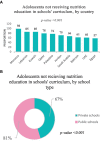Status and correlates of food and nutrition literacy among parents-adolescents' dyads: findings from 10 Arab countries
- PMID: 37200945
- PMCID: PMC10186151
- DOI: 10.3389/fnut.2023.1151498
Status and correlates of food and nutrition literacy among parents-adolescents' dyads: findings from 10 Arab countries
Abstract
Background: Food literacy is capturing the attention worldwide and gaining traction in the Arab countries. Strengthening food and nutrition literacy among Arab teenagers are important promising empowering tools which can protect them from malnutrition. This study aims to assess the nutrition literacy status of adolescents with the food literacy of their parents in 10 Arab countries.
Methods: This cross-sectional study involving a convenient sample of 5,401 adolescent-parent dyads (adolescents: mean age ± SD: 15.9 ± 3.0, females: 46.8%; parents: mean age ± SD: 45.0 ± 9.1, mothers: 67.8%) was launched between 29 April and 6 June 2022 in 10 Arab nations. The Adolescent Nutrition Literacy Scale (ANLS) and the Short Food Literacy Questionnaire (SFLQ) were used to meet the study aims.
Results: More than one-quarter (28%) of adolescents had poor nutrition literacy, with 60% of their parents being food illiterate. The top three countries with nutritionally" less literate" adolescents were Qatar (44%), Lebanon (37.4%), and Saudi Arabia (34.9%). Adolescents' age, gender, education level, primary caregivers, employment status, and the inclusion of nutrition education in the schools' curriculum predicted the nutrition literacy levels of Arab adolescents. Besides, parental weight status, health status, parent's food literacy level, and the number of children per household were significant determinants too. Adolescents studying at a university and having parents with adequate food literacy had the highest odds of being nutritionally literate (OR = 4.5, CI = 1.8-11.5, p = 0.001, OR = 1.8, CI = 1.6-2.1, p < 0.001, respectively).
Conclusion: Nutrition literacy inadequacy among Arab adolescents is a prioritized challenge to be tackled.
Keywords: Arab countries; adolescents; food literacy; nutrition literacy; parents.
Copyright © 2023 Hoteit, Mansour, Mohsen, Bookari, Hammouh, Allehdan, AlKazemi, Al Sabbah, Benkirane, Kamel, Qasrawi, Tayyem and the regional food literacy group.
Conflict of interest statement
The authors declare that the research was conducted in the absence of any commercial or financial relationships that could be construed as a potential conflict of interest.
Figures


Similar articles
-
Parent's food literacy and adolescents nutrition literacy influence household's food security and adolescent's malnutrition and anemia: Findings from a national representative cross sectional study.Front Nutr. 2022 Dec 30;9:1053552. doi: 10.3389/fnut.2022.1053552. eCollection 2022. Front Nutr. 2022. PMID: 36643976 Free PMC article.
-
What is the level of nutrition literacy of Saudi adolescents? A national wide exploratory cross-sectional study.Front Nutr. 2023 Jan 12;9:1113910. doi: 10.3389/fnut.2022.1113910. eCollection 2022. Front Nutr. 2023. PMID: 36712527 Free PMC article.
-
A cross-sectional exploratory study of food literacy among Saudi parents of adolescent children aged 10 to 19 years.Front Nutr. 2023 Jan 6;9:1083118. doi: 10.3389/fnut.2022.1083118. eCollection 2022. Front Nutr. 2023. PMID: 36687688 Free PMC article.
-
Inclusion of children with developmental disabilities in Arab countries: A review of the research literature from 1990 to 2014.Res Dev Disabil. 2016 Feb-Mar;49-50:60-75. doi: 10.1016/j.ridd.2015.11.005. Epub 2015 Dec 8. Res Dev Disabil. 2016. PMID: 26672678 Review.
-
Food literacy competencies in youth - a mini-review.Front Public Health. 2023 Jul 20;11:1185410. doi: 10.3389/fpubh.2023.1185410. eCollection 2023. Front Public Health. 2023. PMID: 37546302 Free PMC article. Review.
Cited by
-
Exploring university students' nutrition literacy in Saudi Arabia: a cross-sectional survey.Front Nutr. 2024 Aug 7;11:1425650. doi: 10.3389/fnut.2024.1425650. eCollection 2024. Front Nutr. 2024. PMID: 39171109 Free PMC article.
-
Assessment of food-related knowledge and preferred awareness methods by the Saudi community: a cross-sectional study.BMC Public Health. 2025 Aug 12;25(1):2742. doi: 10.1186/s12889-025-23921-8. BMC Public Health. 2025. PMID: 40797196 Free PMC article.
-
The Status of Food and Nutrition Literacy and its determinants among Elementary School students in Egypt: community nursing-led design.BMC Nurs. 2024 Oct 2;23(1):708. doi: 10.1186/s12912-024-02342-9. BMC Nurs. 2024. PMID: 39358722 Free PMC article.
-
Association between nutrition literacy and diet quality among adolescents and young adults in the rural district of Mayuge, Eastern Uganda.BMC Public Health. 2025 Jul 3;25(1):2335. doi: 10.1186/s12889-025-23498-2. BMC Public Health. 2025. PMID: 40611004 Free PMC article.
-
Turkish version of the 'food and nutrition literacy questionnaire for Chinese school-age children' for school-age adolescents: a validity and reliability study.BMC Public Health. 2023 Sep 16;23(1):1807. doi: 10.1186/s12889-023-16732-2. BMC Public Health. 2023. PMID: 37716935 Free PMC article.
References
-
- United Nations International Children’s Emergency Fund (UNICEF) . Hunger and malnutrition in the Arab region stand in the way of achieving zero hunger by 2030. (2021). Available at: https://www.unicef.org/mena/press-releases/hunger-and-malnutrition-arab-... (Accessed on 2 June, 2022).
-
- Food and Agricultural Organization (FAO), International Fund for Agricultural development (IFAD), United Nations International Children’s Emergency Fund (UNICEF), World Food Program (WFP), World Health Organization (WHO), & Economic, Social Commission for Western Asia (ESCWA) . Near east and North Africa regional overview of food security and nutrition 2020: Enhancing resilience of food Systems in the Arab States. (2021). Available at:. https://reliefweb.int/report/world/near-east-and-north-africa-regional-o... (Accessed on 17 June, 2022).
-
- Economic and Social Commission for Western Asia (ESCWA) and Food and Agricultural Organization (FAO) . (2021). Arab food security: Vulnerabilities and pathways - Lebanon. Available at: https://reliefweb.int/report/lebanon/arab-food-security-vulnerabilities-... (Accessed on 2 June, 2022).
-
- Agence France-Presse (AFP) . A third of people in 420m-strong Arab world do not have enough to eat Arab News; (2021). Available at: https://www.arabnews.com/node/1988326/middle-east (Accessed June 17, 2022).
LinkOut - more resources
Full Text Sources
Miscellaneous

